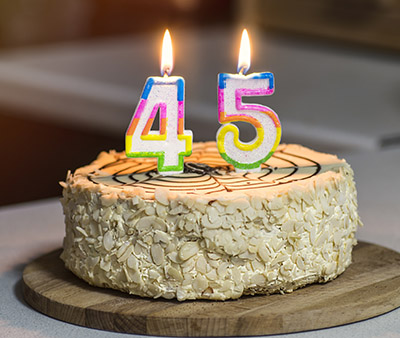 Congress enacted the Education for All Handicapped Children Act (Public Law 94-142) (EHA), in 1975, to support states and localities in protecting the rights of, meeting the individual needs of, and improving the results for infants, toddlers, children, and youth with disabilities and their families. This landmark law, whose 45th Anniversary we celebrate this year, is currently enacted as the Individuals with Disabilities Education Act (IDEA), as amended in 2004.
Congress enacted the Education for All Handicapped Children Act (Public Law 94-142) (EHA), in 1975, to support states and localities in protecting the rights of, meeting the individual needs of, and improving the results for infants, toddlers, children, and youth with disabilities and their families. This landmark law, whose 45th Anniversary we celebrate this year, is currently enacted as the Individuals with Disabilities Education Act (IDEA), as amended in 2004.
Here’s a timeline of how IDEA got where it is today, with nearly twice as many students with disabilities served as in its early days, and 95% of total students now served in the regular classroom at least part of the day.
By 1975, Congress had determined that millions of American children with disabilities were still not receiving an appropriate education, “More than half of the handicapped children in the United States do not receive appropriate educational services which would enable them to have full equality of opportunity” (EHA, §3(b)(3)).
November 29, 1975 – President Gerald Ford signed into law the Education for All Handicapped Children Act (Public Law 94-142).
In the 1976-77 school year, 3,694,000 students aged 3 through 21 were served under EHA.
Public Law 94-142 included efforts to improve how children with disabilities were identified and educated, to evaluate the success of these efforts, and to provide due process protections for children and families. In addition, the law authorized financial incentives to enable states and localities to comply.
October 8, 1986 – Public Law 99-457, reauthorized the Education for All Handicapped Children Act.
In the 1980-81 school year, 4,144,000 students aged 3 through 21 were served under EHA.
The 1986 reauthorization mandated that individual States provide services to families of children born with disabilities from the time they are born. Previously, these services were not available until a child reached the age of three.
January 1, 1990 – The Education for All Handicapped Children Act became the Individuals with Disabilities Education (IDEA), public Law 102-119.
The 1990 reauthorization added traumatic brain injury and autism as new disability categories. Additionally, Congress mandated that as a part of a student’s Individualized Education Program (IEP), an individual transition plan, or ITP, must be developed to help the student transition to post-secondary life.
In the 1990-91 school year, 4,710,000 infants, toddlers, children, and youth with disabilities from birth through age 21 were served under IDEA.
During the 1992-93 school year, 631,621 teachers and related service personnel were employed to serve students age 3 through 21.
Of students with disabilities ages 14 through 21 who are known to have left school, 52% graduated with a regular diploma in the 1994-95 school year, 63% graduated with a regular diploma or certificate of completion, and 34% dropped out.
June 4, 1997 – Public Law 105-17 reauthorized the IDEA and the IDEA received significant amendments.
Whereas Public Law 94-142 issued a national challenge to ensure access to education for all children with disabilities, the 1997 amendments to IDEA articulated a new challenge to improve results for these children and their families. This included an emphasis on access to the general curriculum. Additionally, States were given the authority to expand the “developmental delay” definition to also include students up to age nine. The Law also required parents to attempt to resolve disputes with schools and Local Educational Agencies (LEAs) through mediation, and provided a process for doing so.
In the 2003-04 school year, 6,998,647 infants, toddlers, children, and youth with disabilities from birth through age 21 were served under the IDEA.
December 3, 2004 – Public law 108–446 amended the IDEA to the Individuals With Disabilities Education Improvement Act of 2004.
The 2004 reauthorization called for early intervention for students, greater accountability and improved educational outcomes, and raised the standards for instructors who teach special education classes. The 2006 regulations required schools to use research based interventions in the process of assisting students with learning difficulties or determining eligibility for special education.
In the 2005-06 school year, 695,466 teachers and related service personnel were employed to serve students age 3 through 21.
In the 2017-18 school year, 72.7% of students with disabilities, age 14-21, exiting school graduated with a regular high school diploma and 16% dropped out.
In the 2017-18 school year, 942,446 teachers and related service personnel were employed to serve students age 3 through 21.
In the 2018-19 school year, 7,539,553 infants, toddlers, children, and youth with disabilities from birth through age 21 were served under IDEA. 95% of students with disabilities ages 6-21 are served in a regular classroom at least part of the day.
Sources
United States Department of Education, Office of Special Education and Rehabilitative Services. “History: Twenty-Five Years of Progress in Educating Children With Disabilities Through IDEA”. http://www.ed.gov/policy/speced/leg/idea/history.pdf
U.S. Department of Education, Office of Special Education Programs, “Annual Report to Congress on the Implementation of the Individuals with Disabilities Education Act”, selected years, 1979 through 2019. https://www2.ed.gov/about/reports/annual/osep/index.html#1995
U.S. Department of Education, EDFacts Data Warehouse (EDW): “IDEA Part B Personnel Collection”, selected years, 2005-06 through 2017-18. Data from 2005-2011 includes US and Outlying areas data from 2012 – 2017 includes the US, Outlying Areas, and Freely Associated States.
https://www2.ed.gov/programs/osepidea/618-data/state-level-data-files/index.html#bp
U.S. Department of Education, EDFacts Data Warehouse (EDW): “IDEA Part B Exiting Collection,” 2017-18. Data extracted from: http://go.usa.gov/xdp4e.

 .
.